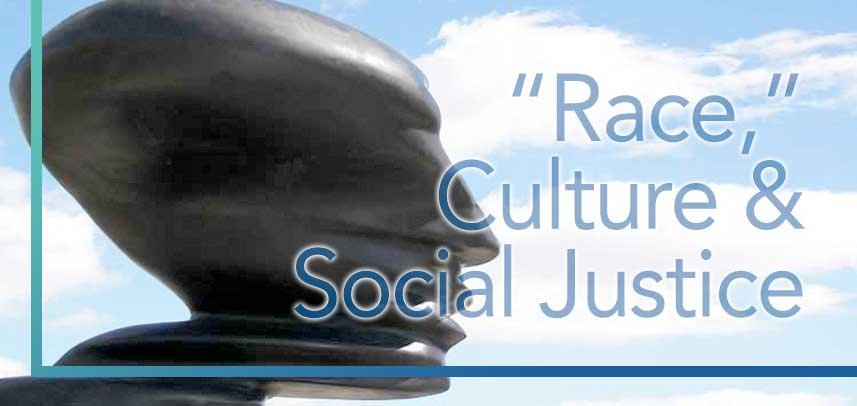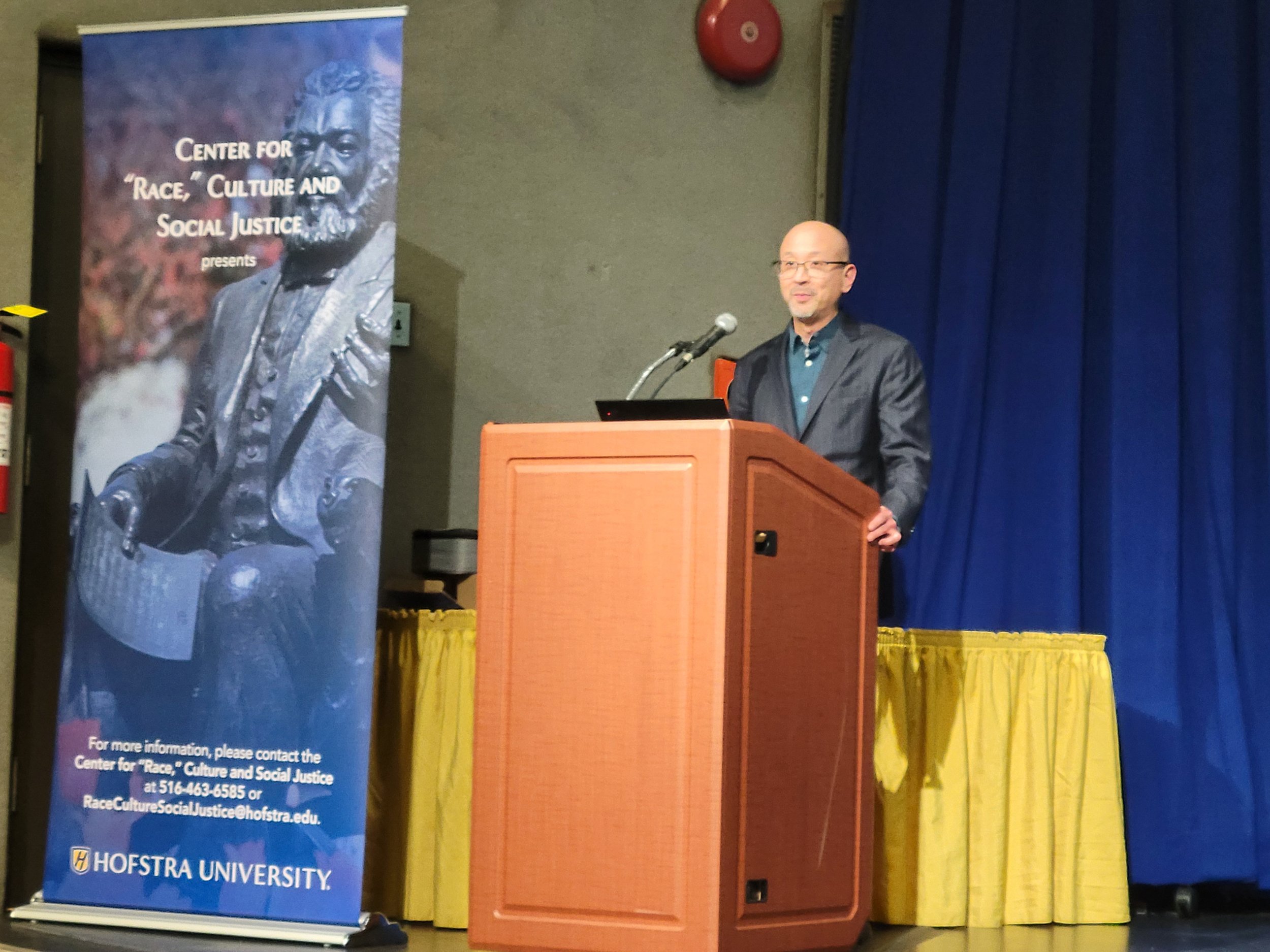The Center for “Race,” Culture and Social Justice celebrates seven years of service to the Hofstra community in race and social justice issues. // Moriah Sukhlal / The Hofstra Chronicle.
Hofstra University’s Student Center Theater was filled with an exuberant crowd on Wednesday, March 13, as faculty and students gathered to celebrate the Center for “Race,” Culture and Social Justice’s seventh anniversary and to welcome the new interim dean of the School of Education, Kevin Kumashiro.
The Center for “Race,” Culture and Social Justice has served Hofstra and the local community since its conception on March 8, 2017. According to Jonathan Lightfoot, the center’s director and a professor of teaching, learning and technology, the center resulted from the 2016 American Association of University Professors’ contract negotiations. At the time, there were not many faculty members of color employed at Hofstra.
“Our appeal to the president and provost at the time was to support our vision of creating a center that addressed that concern by demonstrating to prospective and current faculty that we have the scholarship, the research, teaching and service, particularly when rendered at the intersection of issues of race and racism, diversity, equity, inclusion and social justice for historically marginalized and oppressed peoples,” Lightfoot said.
Throughout its history, the center has worked to give a voice to scholars of color and bring light to pressing social justice issues on Hofstra’s campus. “We hosted monthly colloquium series [and] offer a competitive faculty summer research grant and an African scholars distinguished lecture,” Lightfoot said.
Recently, the center launched its podcast series “Critical Conversations: For the Culture.” The first season explored the intersection of politics and race amidst the repeal of affirmative action and its implication for the future of education.
Holding true to their mission of assisting to ensure diversity among Hofstra’s faculty, the center “takes credit for Hofstra hiring its first chief diversity and inclusion officer … and reviving the Africana Studies program,” Lightfoot said.
In his opening remarks, Lightfoot emphasized the need to name the current moment that implicates the U.S. political and educational climate. In a time of book banning, fear of critical race theory, lowered access to reproductive healthcare and rampant institutional racism, “educators are walking on eggshells,” Lightfoot said.
To expand on the intersections of education, history and politics, which are critical components of the center’s mission in advocating for social justice rights, Kumashiro was invited to provide a distinguished lecture. Kumashiro was the former dean of the School of Education at the University of San Francisco, is an award-winning author and is an expert in educational policy, school reform, teacher preparation, and educational equity and justice.
His interactive lecture, “Aloha Shirts, Hula and Baseball: How Anxieties about and Cultural Technologies toward Hawaii and Japan Helped Shape the U.S. Neo-Empire,” began by asking the audience, “What is the purpose of education?”
“I believe the purpose of education is to expand one’s knowledge and brain functioning as well as building a sense of community within and outside of the classroom,” said Isabella Ritieni, a junior early childhood and childhood education major. “Education also prepares students for adulthood as they acquire numerous skills and they get a sense of how they would like to participate in their community.”
The central theme of Kumashiro’s lecture was to provide an answer to the purpose of education. While education plays a central role in advancing democracy, it also has the potential to hinder it. “It can open our minds, it can also close our minds; it can get us to ask questions, it can also close off the possibilities of imagination,” Kumashiro said.
Interim dean Kevin Kumashiro conducts an interactive lecture asking the audience to consider the purpose of education in regard to the U.S. current state of affairs. // Moriah Sukhlal / The Hofstra Chronicle.
In his lecture, Kumashiro reflected on his childhood in Hawaii. He recounted a personal journey into his family’s history, spurred by the passing of an aunt who left behind a wealth of compiled interviews and materials which led him to explore the cultural significance of aloha shirts, hula and baseball. According to Kumashiro, these artifacts intersect with Hawaii’s history, including its exportation and appropriation by external forces like the U.S. military and how these forces have shaped global perceptions of Hawaiian culture.
“When we think about countries that try to colonize, or basically try to control other people’s lands, one way they accomplish that is through force,” Kumashiro said. “But another way they accomplish that is through messages in education, the stories that we are telling each other.”
Kumashiro explained that aloha shirts, hula and baseball reflect this notion since they are examples of cultural artifacts conveying stories. Stories that tell of other people and places but also “convey stereotypes or simplistic versions of who we are and what we are trying to do in the world,” Kumashiro said.
“[The stories] were so huge to me growing up in Hawaii,” Kumashiro said. “It was only recently that I began to realize that they have these really complicated histories that tell us a lot about the power of cultural stories.”
Kumashiro said that he draws from the works of Paulo Freire, who argued that “we shouldn’t dive too quickly down a path to solve a problem until we first more deeply understand what that problem is.”
Concerning Lightfoot’s previous emphasis on naming the moment, Kumashiro asked the audience to consider, “How would you name the moment that we are in, particularly regarding the intervention that education should be making in this moment?”
Ashish Perukari, a graduate business student, reflected on the pliant nature of education to recent inventions and said, “Perhaps, for the first time after the industrial revolution, the education system is facing a serious crisis … With new inventions, all the age-old [post-colonial] ideas of what education is meant to do are being broken every day.”
When made public to the general masses, schools have historically “played the sorting mechanism in society,” explained Kumashiro. Schools were established to socialize the growing population, teach them how to fit into society and affirm the social hierarchy. While Kumashiro asserted that education plays a role in “allowing a group to maintain control,” he did acknowledge that education is contradictory.
“Even when you set up a system to teach people to think a certain way, people will always end up thinking in multiple ways,” Kumashiro said.
The center hopes to expand on Kumashiro’s beliefs on education in the future.
“The center’s future rests on securing more outside funding so it can be comparable to similar institutions of greater size and impact,” said Veronica Lippencott, the associate director of the center and an adjunct associate professor of global studies and geography. “We need dedicated staff so that the directors can focus on more research, publications and more campus and community initiatives.”
In reflection on the current state of affairs, Kumashiro expressed that education should be unpredictable. “It should be allowing people to come up with answers that you haven’t yet anticipated,” Kumashiro said.








